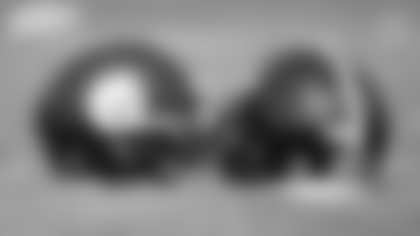Let's get to it:
VICTOR VALE FROM SPRING, TX: I really enjoy your answers, and will not be offended if you criticize me for asking a question you answered for me last year, but it still seems relevant given the questions about the wide receiver position. Will Darnell Washington get some targets this year, or is he going to be a de facto offensive lineman his whole career?
ANSWER: In 2023, TE Darnell Washington was targeted 10 times, and he finished with 7 catches for 61 yards (8.7 average), and his targets averaged 6.1 yards, which shows he was used simply as a dump-off option for the quarterback. This is a new offense the Steelers will be employing this season, and it's said to be one that will utilize the tight end position more and utilize it in a variety of ways. Based on that it's logical to assume Washington could be involved more as a receiver, but that likely will become more clear once the 53-man roster is determined and we learn how many tight ends are kept and who those players are. Regardless of how the roster works out, I still would caution fans hoping to see Washington used in patterns the same way as Pat Freiermuth or Connor Heyward.
SCOTT RANDALL FROM CONWAY, SC: We saw the hamstring injury to Jaylen Warren, and we don't know the extent of the injury yet. Watching the game vs. Buffalo, I really thought La'Mical Perine ran well. What do you think?
ANSWER: This is a guess on my part, and a guess tinged with optimism (which is somewhat out of character for someone who lives in his fears). Anyway, I'm going to hope that Jaylen Warren's hamstring injury isn't the kind that will land him on injured reserve, which would mean he would miss at least the first four games of the regular season. Proceeding along with this line of guessing, Warren would start the season on the 53-man roster and the depth chart at running back would include Najee Harris, Warren, Cordarrelle Patterson, and fullback Jack Colletto. Then the running back the Steelers add to their practice squad would be a game day active who is automatically returned to the practice squad for the first couple of weeks of the regular season until Warren is ready to play.
Now, who might that practice squad running back be? La'Mical Perine certainly would be in the mix, along with Jonathan Ward, Aaron Shampklin, and Daijun Edwards. Here are their respective preseason totals so far: Perine has 10 carries for 30 yards and has played 11 snaps on special teams; Ward has 6 carries for 26 yards and has played 13 special teams snaps but he didn't play vs. Buffalo after injuring a hamstring during the final practice in Latrobe; Shampklin has 4 carries for 15 yards and played 4 special teams snaps; and Edwards has 5 carries for 34 yards and played 6 special teams snaps. Health and special teams value both will be critical considerations here.
JODY SA DOYLE FROM SANTEE, CA: My Dad took me to the old Cleveland Municipal Stadium to see my first Steelers game. It was December 1972, and the Steelers beat the Browns, 30-0. I understand Steelers philosophy – defense first because if the opponent can't score, they can't win, and they can't score if they don't have the ball. I get it. But I have been forced to accept Joe Walton and Matt Canada, and through 2 preseason games, Arthur Smith. Do you, personally, believe Arthur Smith can direct this offense to the end zone on a consistent basis? Because I don't, and I see Joe Walton all over again.
ANSWER: Your memory is playing tricks on you, because while the Pittsburgh-Cleveland game that was played in December 1972 was a 30-0 victory for the Steelers, the site was Three Rivers Stadium. Moving on, I couldn't disagree more with your characterization of Arthur Smith being in the same category as Joe Walton and Matt Canada. Joe Walton took over an offense that was good enough to get the Steelers to within 1 point of a spot in the 1989 AFC Championship Game on the basis of a physical running game backed by down-the-field passing to wide receiver Louis Lipps, and he decided to turn it into a tight-end-focused offense. And Matt Canada never adjusted to the difference between a college football offense and an NFL offense. Making that kind of a judgement after just two games – and two preseason games at that – is premature and a bit unfair, in my opinion.
GRANT SPELLERBERG FROM CUTLER BAY, FL: In the loss to the Bills I noticed that we didn't play our No. 3 quarterback. What was the reason for that?
ANSWER: I am going to assume that the reason Kyle Allen didn't play in the second preseason game was that he had seen a good bit of action in the preseason opener, and it was determined that the playing time last Saturday night was needed to get Russell Wilson his first snaps with his new team and to continue the development process of Justin Fields, who figures to be the backup come the regular season. Once the regular season begins, the best outcome for the No. 3 quarterback, and that's what Allen will be, is for him to be the emergency quarterback for 17 straight games.
JOHN RECHEL FROM LEESPORT, PA: Who decides on what numbers are unofficially retired? If a monster free agent was brought in and had a condition of wanting to wear an unofficially retired number, who would give consideration to that on a case by case situation?
ANSWER: There are no "unofficially retired" jersey numbers. There are, however, jersey numbers that have been taken out of circulation. And if you think there exists any "monster free agent" who could successfully attach the condition of his signing with the Steelers to wearing jersey No. 12, or No. 58, as examples, you don't know much about Steelers President Art Rooney II and what he values when it comes to his stewardship of the franchise his grandfather founded in 1933.
TOM BRUZDA FROM WILDOMAR, CA: The Steelers and all other teams must cut 37 players from the 90-man roster on Aug. 27. What happens next for those players? Do the Steelers have a priority to sign any of those players to their practice squad, or do the players go into a general pool where any team can sign them?
ANSWER: By 4 p.m. EDT on Aug. 27, all teams cut their roster to 53 players. Players with 4 or more years of service are released and free to sign with any team that will have them on its 53-man roster. Players with fewer than 4 years of service are waived, and for 24 hours can be claimed by any of the other 31 teams in the league. Waiver claims are awarded in reverse order – like the NFL Draft where teams with the worse records come first. Twenty-four hours after the cut-down, teams then are permitted to sign players to their practice squads. All unclaimed or unsigned players are free to choose which practice squad they want to join.
JEFF KYLE FROM FT MYERS, FL: I thought Rob King was the new "voice of the Steelers" replacing the great Bill Hillgrove? Is that radio only?
ANSWER: Bill Hillgrove only called games on the radio, too. The play-by-play announcers for televised regular season and postseason games are chosen by the network broadcasting the game.
BILL BROWN FROM VIRGINIA BEACH, VA: Can we say the quiet part out loud? Trading Diontae Johnson was a bad move even if he didn't have the best attitude. Just asking your personal opinion being that you have some insights.
ANSWER: Are you saying that a No. 2 wide receiver in the NFL is more valuable to a team than a No. 2 cornerback? Because I'm not willing to say that.
ED JOHNSON FROM GERMANTOWN, OH: I know that Steelers quarterbacks start from the shotgun position most of the time. Am I correct in thinking that Roger Staubach of the Cowboys was the first to use it? I am old enough to remember that all quarterbacks always lined up under center.
ANSWER: I found this on profootballhof.com, and it's a comprehensive history of the shotgun formation:
"Although it is used today by nearly every team in the National Football League, the popular shotgun formation is nothing new. The San Francisco 49ers, under head coach Red Hickey, unveiled a version of the now-popular formation in 1960. However, even Hickey's shotgun was really just a new version of an old formation. Veteran coaches likened it to Pop Warner's Double Wing B-formation that was introduced at Stanford some thirty years earlier, or the short punt formation that had been used by numerous teams through the years.
"Regardless of its origins, Hickey's version brought excitement and lopsided wins to a then-otherwise lackluster 49ers team. San Francisco first used the shotgun on November 27, 1960, in a game against the Baltimore Colts. Hickey knew the Colts had a terrific pass rush, so in preparing for the game he had his quarterbacks practice taking snaps seven yards deep rather than from under center. This, he reasoned, would not only give his quarterbacks more time to spot receivers, but also cause the Colts to rethink their defensive alignment. He was right on both accounts.
"The result was a stunning 30-22 upset of the heavily-favored Colts. The 49ers' attack was actually orchestrated by third-string quarterback Bob Waters who was filling in for backup John Brodie who replaced an injured Y.A. Tittle. Brodie went down with an injury early in the game after a ferocious hit by Colts defensive tackle Big Daddy Lipscomb. What really surprised the Colts, however, was the 49ers' ability to run from the shotgun. San Francisco went on to win three of their final four games using the formation with Brodie emerging as the starter. He became known as "the man who pulled the trigger of the shotgun."
"In 1961, the 49ers added rookie tailback/quarterback Bill Kilmer to their offensive arsenal. Hickey used Kilmer, Brodie, and Waters on an alternating basis and sent in plays with each new man.
"The 49ers, with their three-quarterback shotgun offense, got off to a quick 4-1 start that included 49-0 and 35-0 wins over the Detroit Lions and the Los Angeles Rams. However, in a game against the Chicago Bears on October 22, the shotgun misfired. Bears linebacker Bill George found a weakness. Instead of lining up in his usual linebacker spot, George moved up to the line of scrimmage. With his added presence, the Bears were able to penetrate by attacking the center and getting through to the quarterback. After harassing 49er quarterbacks all afternoon, the Bears clobbered San Francisco 31-0.
"Soon after that game, Hickey figured the shotgun was dead and retired the formation. However, several years later, the formation returned when Tom Landry and the Dallas Cowboys added a refined version to their offensive strategy."













